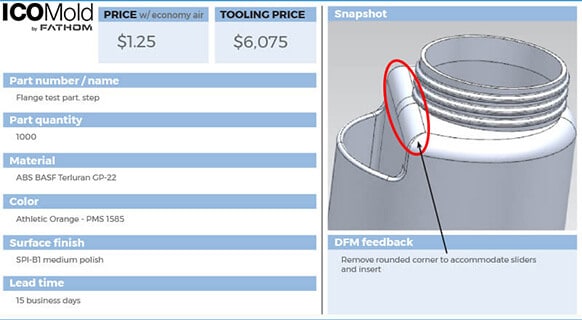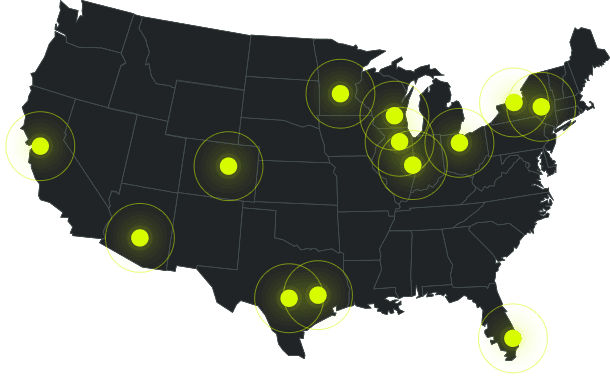About Laser Cutting
High speed coupled with high quality makes laser cutting very cost-competitive and a real value for our customers. CNC controls guarantee critical tolerances while accommodating fine features and larger blank sizes, making laser cutting an ideal process for prototype to low-volume production quantities. Laser cutting produces intricate and complex parts with high-quality edge finishes, without the added time or custom tooling cost. A popular manufacturing method, industries such as aerospace, automotive and medical have all incorporated laser cutting due to its many benefits. Our experts specialize in laser cutting. Talk to us today about your laser cutting project and how your project can take advantage of laser cutting’s high quality and accuracy.
Metal Laser Cutting Services
Fathom provides nationwide access to precision laser cutting services using state-of-the-art laser cutting machines. Whatever your desired outcome, we have a cutting solution to meet the goal.
Sheet Metal & Forming
Manufacturing Services
Sheet Metal Fabrication
Water Jet Cutting
Micro Water Jet Cutting
Laser Cutting
Chemical Etching
Wire EDM
Cutting Techniques Summary and How Laser Cutting Compares
| Material Thickness | Tolerance | Kerf | Part Volume | Set Up Cost | Lead Time ** | Notes | |
|---|---|---|---|---|---|---|---|
| FIBER LASER | AL: 0.250″ SS: 0.375″ CRS: 0.500″ COP: 0.250″ Brass: 0.125″ | 0.002″ – 0.005″ | .008″ | 1 to High-Volume | Low | 6-8 days | Metals – Fast |
| OMAX WATERJET | Up to 6″ | 0.005″- 0.015″ | .020″/.040″ | 1 to 5000 | Low | 6-8 days | Metal, glass, plastic, stone, rubber, kevlar, carbon fiber, ceramics, etc. Taper up to 59 ° |
| MICROCUT™ | .0005″ – 0.5″ | 0.0005″ -0.005″ | 0.009″, 0.011″, 0.0196″ | 1 to 5000 | Low | 6-8 days | Metal, glass, plastic, stone, rubber, kevlar, laminates, carbon fiber, ceramics, etc. |
| WIRE EDM | 0.001″ – 6″ | 0.0005″ | 0.005″ | 1-200 Is Best | Low | 6-8 days | Conductive Metals, Carbon |
| * CHEMICAL ETCHING | 0.005″ – 0.060″ | Is +/- 10% of material thickness, .002″ min. | Equal to metal thickness | 1- Infinity | $350 Min. | 6-8 days | Metal Only. No Burrs. Beveled Edges. Half Etch and Holes. |
* Inner radius should be 100% of material thickness. Outer Radius should be 75% of material thickness.
**Dependent on geometry, volume and material: EXPEDITE options available.
How Does Laser Cutting Work?
Laser cutting is a manufacturing technique that utilizes a high-powered laser beam to cut, engrave or mark material. Laser cutting can be used with a wide range of materials, from metal to paper. There are multiple types of laser cutting machines categorized by gas, liquid or solid-state. CO2 lasers are a gas state laser which use a carbon dioxide mixture to cut. Solid-state lasers, such as the fiber optic laser, use laser diodes transmitted through optical fibers to create the desired cuts. The laser cutting machine uses no mechanical components and makes its cuts within an enclosure. This means the operation produces less noise and decreases the personal risk of the operator.

Benefits of Laser Cutting
Laser cutting offers many advantages compared to other cutting options, including:
- Better cutting precision and accuracy
- Higher quality cut edges
- Narrower kerf widths
- Limited material distortion, contamination and waste
- Less maintenance and repair costs
- Better operator safety
- Quick set-ups
Compared to conventional cutting machines and technology, laser cutting machines can cut a wide range of designs with a more superior degree of precision and accuracy. Laser cutting can be fully CNC controlled, which allows for laser cutting machines to repeatedly and consistently produce complex and intricate parts. Also, laser cutting yields higher-quality cuts which typically do not require additional cleaning or finishing. This in turn decreases the need for additional finishing.
Laser Cutting Specifications
Fiber Optic Laser
A fiber optic laser is a laser that uses an active medium as the optical fiber that leverages atypical elements such as erbium, praseodymium, holmium and others.
Specifications:
- Blinding max cutting speed of >1,800 inches per minute
- .008 Kerf
- Thickness capacity:
- Aluminum 0.005″ – 0.500″
- Stainless Steel 0.005″ – 0.750″
- CRS 0.010″ – 1.000″
- Copper 0.005″ – 0.375″
Features common to Fiber Optic and CO2 Lasers:
- Feature size tolerance +/- 0.002″
- Linear and position tolerance +/- 0.005″
- 5′ x 10′ sheet processing size
- Automatic pallet changing for optimized production processing
- Material sensing head maintains perfect standoff for optimum edge quality
- Low setup cost
- Fast delivery
The type of laser best suited for a project depends on the material being used. Other factors may also be taken into account for specific applications, including the wavelength, laser power, machine configuration, beam mode and focal spot.
Materials Used for Laser Cutting
Laser cutting can be used for a variety of materials, including aluminum, carbon steel, stainless steel and copper.
Laser Cutting Sheet Metal
CO2 and Fiber laser systems cutting are ideal for cutting sheet metal. In fact, laser cutting sheet metal is one of the more popular methods of traditional sheet metal techniques. This metal cutting option allows for accurate cutting of sheet metals like stainless steel, mild steel, aluminum, copper and brass. Given the high speed and reliability of fiber lasers, laser cutting sheet metal typically ends up ahead of other processes in terms of cost per part, but there are a lot of factors that come into play specific to the end cost of your cutting project.
Laser Cutting Techniques
Laser cutting may involve one or more of the following techniques:
- Laser cutting: The material is cut to create smaller pieces or intricate shapes.
- Laser engraving: A layer is removed from the material, leaving an engraving or design.
- Laser marking: Like engraving, a mark is made on the material’s surface, but it is not as deep as an engraving.
- Laser drilling: Dents or holes are made in the material.

What are the Advantages of Laser Cutting?
Laser cutting has many benefits:
- Higher quality edges
- Control and precision
- Extreme accuracy
- Narrower kerf widths
- Decreased material distortion
- Decreased contamination and waste
- No contact manufacturing process
- Low maintenance and repair costs
- Operator safety
Which Industries Use Laser Cutting?
Laser cutting can be used for a range of applications and industries, including:
- Aerospace
- Automotive and electric vehicle components
- Medical device manufacturers
- Many others
How Laser Cutting Companies Differ
Different laser cutting companies can differ based on the specific type and volume of laser cutting they offer. Each will come with specific expertise and may specialize in different industries. Fathom provides nationwide access to precision laser cutting services using state-of-the-art laser cutting machines. Whatever your desired outcome, we have a cutting solution to meet the goal.
History of Laser Cutting
Using lasers for manufacturing is a relatively new technique. The first laser was developed in the 1960s. Initially, laser cutting was used to drill in diamond mines. By 1967, the British created a laser machine powerful enough to cut metal and was eventually used to cut titanium for aerospace use. Gas laser cutting was invented in 1964 and was initially used to cut softer textiles. During the 1980s, the popularity of laser cutting increased significantly, with over 20,000 machines installed. Since then, laser cutting has rapidly evolved and is used for diverse applications.
Laser Cutting Cost Calculation
Laser cutting costs can vary based on the type of material being cut, volume and other project criteria. Most cost calculations are calculated based on the time a job takes on the laser. Of course this is dependent on the variables mentioned above. So in the end, laser cutting cost calculations can vary greatly.
















